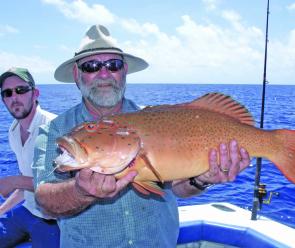It has been exciting times in the region with all forms of fishing delivering the goods. Combined with fair weather conditions, although a touch warm, it has been happy days.
The big news at this time of year has been the black marlin season. This kicked off in early September with the first reports of blacks being tagged and released on our local grounds at Linden Bank and Opal Ridge. It was an early start to the mating season and as usual they started small, around the 200-300lb mark, but soon turned into 500lb+ fish a week or two later. As the days continued and the charters filled their days, the capture rate increased dramatically with some boats seeing several hook-ups per session.
There is still a long way to go with the anticipated bite to peak this coming month with 1000lb fish a likely outcome. There is a strong contingency of game boats based in Port Douglas this year with experienced crews aboard and one feels it will be a bumper season.
Other good news to support the game efforts is that the yellowfin and wahoo population showed up in good numbers on the shelf mid September and have offered plenty of action on the lighter gear. Many operators opt for a bit of light game fun in the mornings before turning their attention to the heavy tackle in the afternoon.
All the seasons started earlier this year with higher than normal temperatures experienced. One example is the crocodiles began mating ahead of normal schedule by a month or two and they had done their business by the end of September. And the same could be said offshore with the coral trout well and truly roed up by mid September and the new moon of October could see most of the spawning action take place, if not all of it. The November reef closure may become a waist of time if this was to occur. We'll have to wait and see if the reef fin species are in ovulating mode leading into this next new moon due mid November.
In saying this, big plump coral trout have been the order of the day with an average weight of 4-6kg. They have been congregating to breeding grounds in the shallows and biting aggressively. Sometimes they are hitting baits that hard that they nearly rip your arms off in the process. Other species competing on similar turf are stripeys, Moses perch, slatey bream and sweetlip, all with a bit more vigour in their attitude.
Going deeper, the large mouth nannygai have remained consistent although sharks are still continuing to be a menace a lot of the time by plucking off fish at will. Night efforts have produced better results on the nannygai when the shark activity has been far less. Surprisingly this year the small mouth nannygai never truly showed up in numbers except for juvenile species located closer to shore.
The Spanish mackerel continued to bite well throughout the initial stages of our warmer months and could be found in large schools from juveniles to 15kg species, with many of them full of roe. They've been active in a variety of places but the common thread is clean deeper water with significant structure below and holding bait schools. The bigger mackerel have been taken on live baits with a couple of monsters recorded on the 30kg mark.
Inshore the fishing has been tough going at times during the middle parts of the hot days with most action occurring after dark or on dusk/dawn periods. This has been the case for most species including barra (no take now), fingermark and mangrove jack. The queenfish and trevally are active during low light periods on the incoming tides with less action during the middle parts of the day.
For us to see more activity during the day we'll need some much needed rain in the region to ignite our rivers and creeks into action. No doubt this will not be too far away as we enter the official start to the wet season.
Reads: 1562
Coral trout have remained a consistent catch offshore, but have they fully completed their spawning in October? Time will tell.




